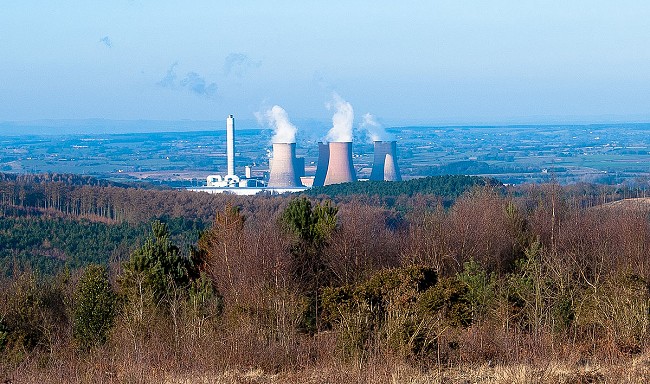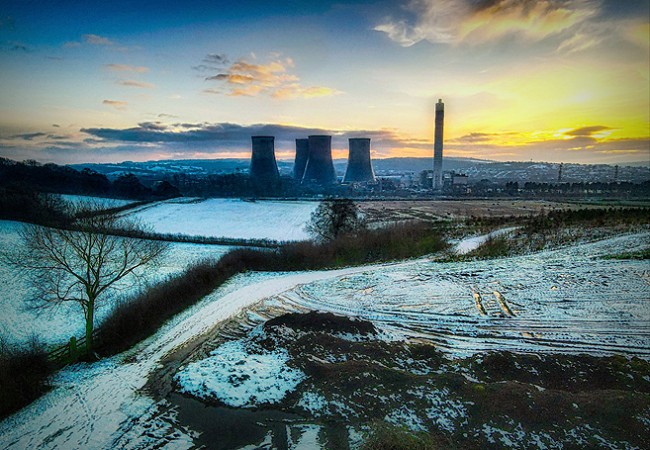When the last cooling tower at Rugeley B Power Station in Staffordshire comes down, the skyline that I have known nearly all my life will be gone forever. It has been visible for miles and seeing it on your way back home told you that you would soon be able to put your feet up and have a cuppa.
The power station is built partly in the Parish of Armitage-with-Handsacre and partly in the local town of Rugeley. The first indication that a power station was going to be built there came in 1952 when it was announced that a new pit, Lea Hall Colliery, then still under construction, would be complemented by a power station in the first joint venture between the National Coal Board (NCB) and the Central Electricity Generating Board (CEGB). The coal from the pit would be fed by conveyor straight to the power station.
Over the next four years the design of the power station was finalised for the 900 acre site, two thirds of it being in the Parish of Armitage-with-Handsacre. There would be five generator sets each capable of producing 120,000KW for a total of 600,000KW. Water would be drawn from the adjacent River Trent and there would be five cooling towers (350 ft high) and two boiler chimneys (450 ft high). The base diameter of four of the condensing cooling towers would be 225 ft but the fifth would be an experimental design – a dry cooling tower with a base diameter of 325 ft.
This tower would have nearly three million feet of tubing in it which would act as giant radiator and ensuring that no water would be lost. It was hoped that this design would remove the need for so much cooling water and enabling power stations to be built in dry regions of the world. The design was developed by two Hungarians, L Heller and L Forgo. Most of the site was set aside for five ash lagoons which would be in the north west part of the Parish near the River Trent.
Work started in 1956 and the civils side soon ran into trouble with water-logged conditions in the ash lagoon area. This part of the Parish had originally been the site of Hawksherd Hall, a home of the de Ruggeleys who held a sub-manor under the manor of Handsacre. It had been surrounded by a moat and was reported as a dark, dank building and was abandoned in the mid-17th century. The outline of the hall was clearly visible in 1950 after it was first ploughed by tractor but no archaeological digs were needed before a development in those days and now all such traces are lost beneath enormous lagoons.
After raising the ground levels and sorting out wells the building began in earnest and over the next four years the buildings rose and the towers soared. January 1961 saw the first generating set start work and the station was fully on stream by December 1962.
Before the Power Station was even officially commissioned (in Oct 1963) the CEGB stated that a second Power Station (B) would be built with four normal condensing cooling towers. It would have two 500,000KW turbo generators and one 600 ft chimney. Construction began in 1964 and at the same time a council boundary review was announced, the first since 1934.

Having a Power Station was excellent for the council rates and Rugeley Urban District Council submitted a proposal that would absorb 90% of Armitage-with-Handsacre Parish into the Rugeley District. The rates in Armitage-with-Handsacre (which was in the Lichfield Rural District) were considerably lower than in Rugeley so it wasn’t surprising that the proposal was not met with favour in Armitage-with-Handsacre. The Boundary Commission decided that the part of the Parish that was in the village of Brereton would join the rest of Brereton in the Rugeley District. But Armitage-with-Handsacre retained their portion of the Power Station site.
Lea Hall Colliery and the Power Stations were major employers and it led to a big increase in the population of the Parish, which largely consisted of the villages of Armitage and Handsacre (now a combined village called Armitage-with-Handsacre). The NCB built a 300 house development at Tuppenhurst Lane in Handsacre and private developers built 52 bungalows off Old Road in Handsacre and 38 at the site of the old Rectory in Armitage. Not to be outdone, Lichfield Council joined in and decided to replace the prefabs in Armitage with brick and tile houses and add some bungalows. The 1961 census showed that the population of the Parish was 2,100 but by 1966 it was about 3,500.
Rugeley B Power Station was commissioned in 1970. Given the rapid change in technology and engineering, the life of a Power Station is only about 25 years. Rugeley A Power Station ceased production in September 1994 and was demolished the following year. Big upgrades like the installation of a flue gas desulphurisation plant in 2009 enabled B Power Station to extend its life but it too ceased production – in 2016.
Demolition has started and buildings such as these divide opinion and excite comment – social media sites are a great place to hear the diversity of opinions. Here’s a flavour:
- You know you’re home when you see the giant eggcups, will be sad to see them go.
- Grew up under the shadows of those bad boys.
- ICONIC
- I shall maybe not miss them? tbh… a landmark yes but not overly attractive.
- Cathedrals of industry
- An ugly blot on our landscape.
The photo below shows a December 2020 sunset over the remaining buildings of Rugeley B Power Station – by December 2021 the towers will be no more and the landmark will have disappeared forever.

Picture credits
Rugeley Power Station as viewed from Castle Ring on Cannock Chase, by Wikimedia Commons contributor Bs0u10e01 – CC-BY-SA/4.0 – Modified
Sunset over Rugeley B Power Station, by Dave Edwards of Max400 Aerial Photography – Used with permission
